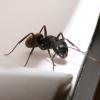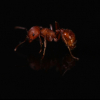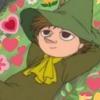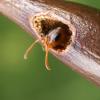
They're a beautiful bold black and red, even though the adult parents are marked in yellow. I'll be very curious how long they will keep the red color.

A friend told me they look like locusts, but they're not related so far as I know. They travel in groups as young nymphs, but are mostly loners as adults, coming together to mate and produce maybe 1-3 egg pods per year, with the eggs overwintering by design. The grasshoppers live maybe six months, and only have one generation a year.
Now, like bees, the coloration of these grasshoppers is a warning. They're toxic in the wild, but mostly because of their diet. They sequester a variety of toxins from the highly variable selection of forbs they eat naturally. It's kind of like dart frogs: perfectly harmless as pets, unless the frogs are allowed to eat their natural diet of a certain small beetle which makes them fiercely lethal.
In Louisiana, these giant, slow, non-flying grasshoppers get ran over and stepped on all the time, but not a damn thing touches their remains: the poisonous dead body of the grasshopper is avoided by every other animal out there, including ants. So, altogether, I find these weird gentle giants fascinating, and I'm happy my collection of eggs is hatching.


















